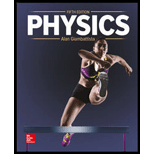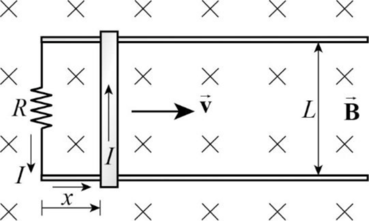
Concept explainers
(a)
The current in the metal rod.
(a)
Answer to Problem 3P
The current in the metal rod is
Explanation of Solution

Figure
Write the expression for the induced emf in the metal rod.
Here,
Write the expression for the current in the metal rod.
Here,
Use equation (II) in (I) to solve for
Conclusion:
Substitute
Therefore, the current in the metal rod is
(b)
The energy dissipated in the resistor.
(b)
Answer to Problem 3P
The rate of energy dissipated in the resistor is
Explanation of Solution
Write the expression for the energy dissipated in the resistor.
Here,
Conclusion:
Substitute
Therefore, the energy dissipated in the resistor is
(c)
The magnetic force on the metal rod.
(c)
Answer to Problem 3P
The magnetic force on the metal rod is
Explanation of Solution
Write the expression for the magnetic force.
Here,
Conclusion:
Substitute
Therefore, the magnetic force on the metal rod is
Want to see more full solutions like this?
Chapter 20 Solutions
Physics
- A particle with a charge of − 5.20 nC is moving in a uniform magnetic field of (B→=−( 1.22 T )k^. The magnetic force on the particle is measured to be (F→=−( 3.50×10−7 N )i^+( 7.60×10−7 N )j^. Calculate the y and z component of the velocity of the particle.arrow_forwardneed answer asap please thank youarrow_forward3. a. Determine the potential difference between points A and B. b. Why does point A have a higher potential energy? Q = +1.0 C 3.2 cm 4.8 cm Aarrow_forward
- 9. When an electron moves into a uniform and perpendicular magnetic field, it will.. a. Accelerate parallel to the magnetic Field until it leaves b. Accelerate in a circular path c. Accelerate perpendicular to both the magnetic field and its original direction d. Repel back into the electric field 10. If a proton at rest is placed in a uniform magnetic field with no electric or gravitational field around, the proton will…….. a. Accelerate in the direction of the magnetic field b. Accelerate in a direction perpendicular to the magnetic field c. Move in a circular path d. Not acceleratearrow_forward7. The electric field at a distance of 1.0 mfrom a charged sphere is 100 N/C. At what distance from thesphere will the electric field be 50 N/C? a. 1.1 m b. 1.4 m c. 2.0 m d. 4.0 m 8. The electric potential due to a point charge at a point depends on a. The direction of the electric field b. The distance from the point charge c. The velocity of the point charge d. The mass of the point chargearrow_forwardPls help ASAParrow_forward
 Principles of Physics: A Calculus-Based TextPhysicsISBN:9781133104261Author:Raymond A. Serway, John W. JewettPublisher:Cengage Learning
Principles of Physics: A Calculus-Based TextPhysicsISBN:9781133104261Author:Raymond A. Serway, John W. JewettPublisher:Cengage Learning Physics for Scientists and Engineers: Foundations...PhysicsISBN:9781133939146Author:Katz, Debora M.Publisher:Cengage Learning
Physics for Scientists and Engineers: Foundations...PhysicsISBN:9781133939146Author:Katz, Debora M.Publisher:Cengage Learning Glencoe Physics: Principles and Problems, Student...PhysicsISBN:9780078807213Author:Paul W. ZitzewitzPublisher:Glencoe/McGraw-Hill
Glencoe Physics: Principles and Problems, Student...PhysicsISBN:9780078807213Author:Paul W. ZitzewitzPublisher:Glencoe/McGraw-Hill
 Physics for Scientists and EngineersPhysicsISBN:9781337553278Author:Raymond A. Serway, John W. JewettPublisher:Cengage Learning
Physics for Scientists and EngineersPhysicsISBN:9781337553278Author:Raymond A. Serway, John W. JewettPublisher:Cengage Learning Physics for Scientists and Engineers with Modern ...PhysicsISBN:9781337553292Author:Raymond A. Serway, John W. JewettPublisher:Cengage Learning
Physics for Scientists and Engineers with Modern ...PhysicsISBN:9781337553292Author:Raymond A. Serway, John W. JewettPublisher:Cengage Learning





